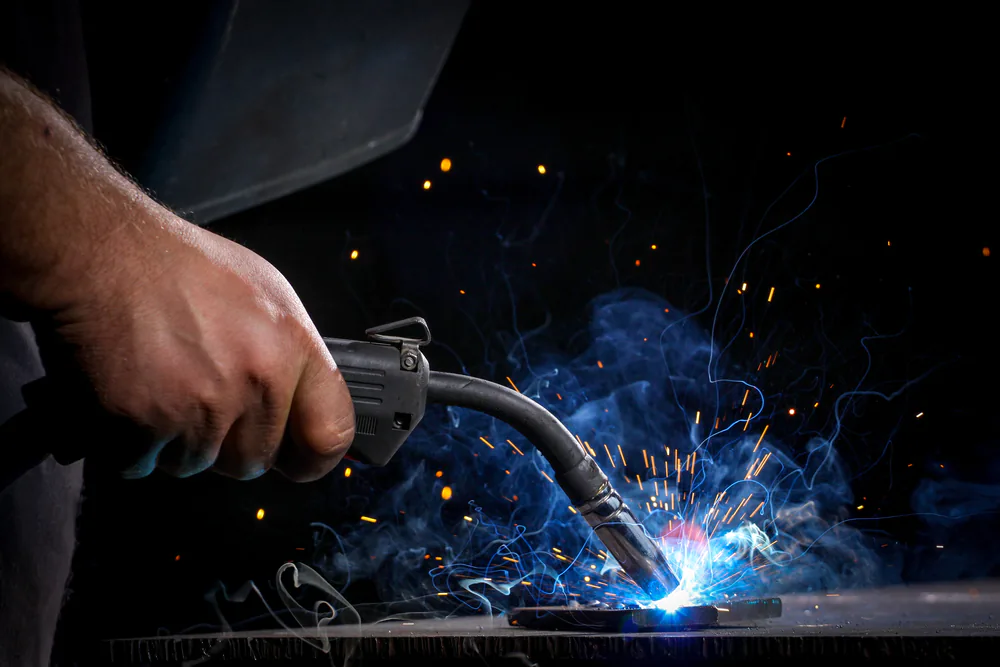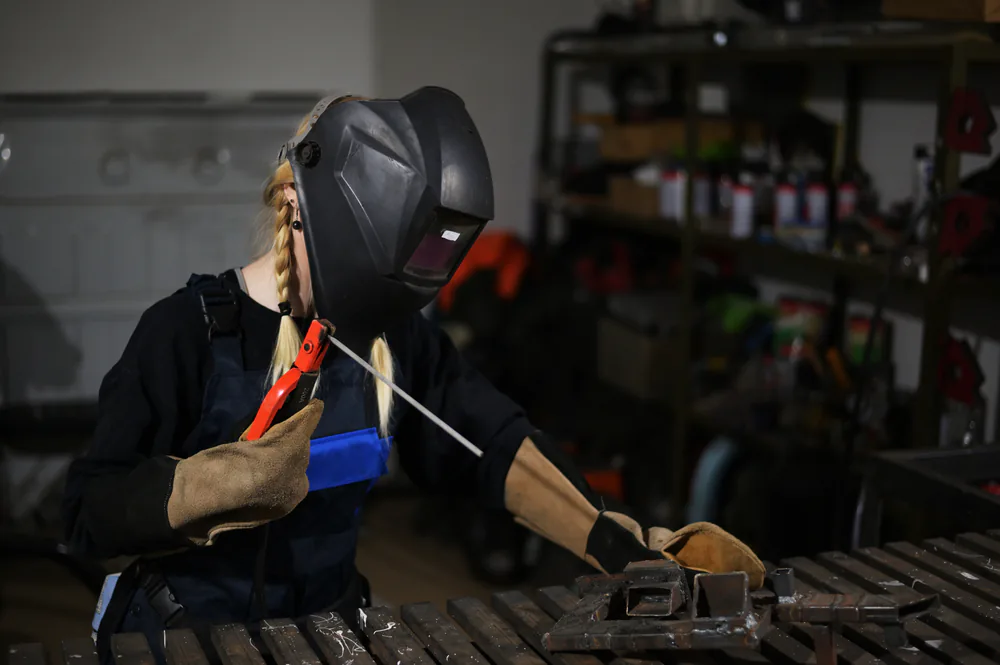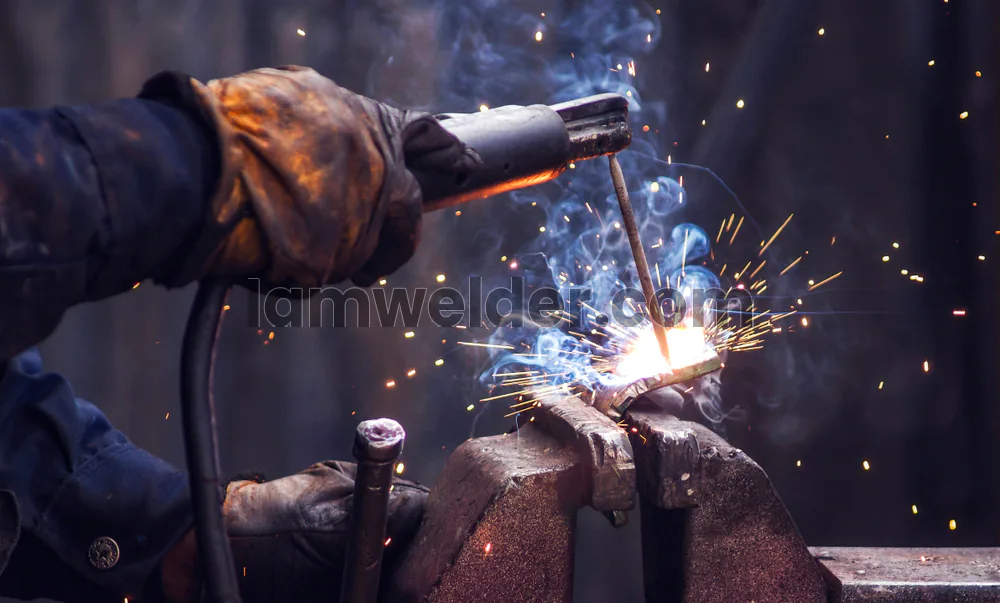Informational
Selecting the Best Gas for MIG Welding [Downloadable Chart]

There is a direct correlation between the type of weld that is produced and the shielding gas that was used during the welding process. The manner in which the metal is distributed, the welding speed, the weld contour, the effect that the arc has on cleaning, and the fluidity of the molten weld pool are some of the properties that may be affected.
So, in this article, we will go over all of the different types of gases that can be used in MIG welding to improve weld quality.
The five most common gases used in MIG welding are Argon, Carbon Dioxide Helium, Oxygen, and Nitrogen. Each gas has its own benefits and problems. But Argon and Its mixes are the most widely used gases for MIG welding.
Choosing the Right Gas Type for Your Job is Not Simple, You Need More Information
As I mentioned earlier, Shielding gas is essential for MIG welding because it prevents the weld puddle from becoming contaminated by the atmosphere. It is critical that the shielding gas moves over the work area at a nice and consistent rate.
The shielding gas supply configuration in a MIG welding operation is relatively simple. The gas is contained in a pressurized cylinder, and a flow meter is used to reduce the pressure of the gas to a workable level.

The gas is then piped into the MIG welding gun and directed onto the molten pool via a nozzle. But the choice of which shielding gas to use for your MIG welding projects is not an easy one.
When deciding which shielding gas to use, there are several options to consider, as well as several criteria to consider. These criteria include the depth of penetration, porosity prevention, welding speed, and, of course, cost.
In the following paragraphs, I’ll give you some additional information to help you decide which approach to your MIG jobs will be the most successful.
Most Widely Used Gases for MIG Welding
There are five most widely used gas types in MIG welding:
- Argon (Ar)
- Carbon Dioxide (CO2)
- Helium (He)
- Oxygen (O)
- Nitrogen (N)
[table id= 19/]
[table id= 20/]
1. MIG Welding With Argon
The atomic symbol for argon is Ar, and it is categorized as an inert gas. Inert gases are those that do not react with other substances and are also insoluble in molten metal.
While welding nonferrous metals such as aluminum, copper, magnesium, and nickel, as well as their alloys, you can use argon at a concentration of one hundred percent; however, pure Argon is not commonly used when welding ferrous metals.
Due to the fact that argon is heavier than air (unlike helium; we will discuss this in more detail in the following paragraphs), you require less of it when welding because it flows directly onto the weld area from the nozzle. This is one of the most significant advantages of argon.
On the other hand, Argon ionization is not very difficult. Gases that ionize quickly may support longer arcs at lower voltages than other kinds of gases. As a result, it is less susceptible to fluctuations in arc length.
Argon or a combination of argon with other gases is good for the axial spray transfer procedure. Helium and/or oxygen are often combined with argon gas for steel welding.
Argon is an excellent choice if you desire a quiet arc with minimal spatter. You should allocate approximately $100 for a large cylinder of argon or argon mixture.
Pros & Cons of Using Argon Gas in MIG Welding
2. MIG Welding With Carbon Dioxide
One carbon (C) and two oxygen (O2) atoms combine to form carbon dioxide, which has the molecular formula CO2. For MIG welding of steels, carbon dioxide at 100% concentration is commonly used as a shielding gas.
In comparison to inert gases, it allows for faster welding speeds, deeper penetration, superior mechanical properties, and a lower price tag. Carbon dioxide has less steady arc characteristics and significantly more weld spatter, which is the main drawback.
The amount of spatter produced can be minimized by keeping the arc length constant and very short. CO2 can create solid welds if a filler wire with the right deoxidizing additives is used.
In comparison to other gases, its low cost (around $12 for a 244-cubic-foot cylinder) makes it a competitive choice.
Pros & Cons of Using Carbon Dioxide Gas in MIG Welding
3. MIG Welding With Helium
Helium, a nonreactive gas with the atomic symbol He, does not react with molten metals either. Helium can help you make wider welds when welding thick pieces of metal, which is very beneficial in some cases.
The main disadvantage is that because helium is lighter than air, it tends to float away from the weld puddle. And typically necessitates a higher flow rate and significantly more gas than would be required when working with, say, argon.
Because helium is less dense than air, its flow rates must be roughly double those of argon to produce enough gas stream stiffness to displace air from the weld area.
When welding in moist conditions, high flow rates are required to provide adequate protection resulting in high gas consumption.
Higher voltage ionization is required, resulting in a hotter arc. When helium is used, the heat generated by the arc significantly increases. This hotter arc makes welding thick sections of aluminum and magnesium easier.
Helium is added in small amounts to heavier gases. These blends take advantage of helium’s high melting point and the other gas’s superior weld coverage. This means that the blended gas benefits from the properties of both gases.
Helium can consist of up to 80% of a helium/argon mix. If you want more power in your arc without losing the spray mode’s other advantages, mix helium with your argon.
As the amount of helium increases, the transfer becomes increasingly globular, which may require you to change the welding technique. Helium costs approximately $10 more per cylinder (244 cubic feet) than argon.
Pros & Cons of Using Helium Gas in MIG Welding
4. MIG Welding With Oxygen
Although pure oxygen is almost never used in MIG welding but oxygen is very helping in gas mixes. It is really good for stabilizing Arc and minimizing the spatter.
Pros & Cons of Using Oxygen Gas in MIG Welding
5. MIG Welding With Nitrogen
Nitrogen is represented by the atomic symbol N. It’s not an absolutely nonreactive gas, but it won’t cause much trouble in the molten weld pool. It is frequently added to blending gases in order to raise the arc’s temperature. Copper and copper alloys can be welded using pure nitrogen.
Pros & Cons of Using Nitrogen Gas in MIG Welding
Best Mixture Gases for MIG Welding
The welding properties of argon may be altered by combining it with oxygen, carbon dioxide, helium, or nitrogen.
By adding reactive gases (oxidizing) to argon, such as oxygen or carbon dioxide, the arc may be stabilized, metal transfer enhanced, and spatter minimized.
As a result, the penetration pattern is improved, and undercutting is eliminated or reduced.
By introducing inert gases such as helium or nitrogen, the arc heat may be enhanced.
To accomplish the desired results, a very minimal concentration of reactive gases such as oxygen or carbon dioxide is required. A change in oxygen level as minor as 0.5% will have a visible effect on the weld.
Blends containing between 1 and 5 percent oxygen are the most common. Two-thirds of the argon volume can be filled with carbon dioxide.
There may not be enough arc voltage in argon + carbon dioxide +oxygen mixtures with less than 10% carbon dioxide to achieve the desired results. Most applications call for a 25% CO2 argon blend.
[table id= 21/]
Filler wire containing deoxidizers should be used when welding with oxidizing shielding gases like oxygen or carbon dioxide to prevent porosity in the weld.
Some alloying elements, like chromium, vanadium, aluminum, titanium, manganese, and silicon, can be lost due to the presence of oxygen in the shielding gas.
100% argon’s cathodic cleaning action corrodes steels. The arc might be drawn to the iron oxide in and on the steel’s surface because it is a good emitter of electrons.
However, because of the uneven distribution of these oxides, arc movement and weld deposits are highly irregular. The issue was resolved by mixing in some oxygen with the argon.
A uniform film of iron oxide is formed by the reaction, which provides a stable site for the arc and strengthens the weld pool.
Thanks to this breakthrough, GMAW can now be used to weld ferrous alloys, greatly increasing its versatility.
Steel alloys have different oxygen requirements for arc stabilization. In most cases, 2% is adequate for carbon and low-alloy steels.
About 0.5% should be sufficient to prevent a refractory scale of chromium oxide in stainless steel.
CO2 is a viable oxygen replacement. However, more than 2% is required, with 8% appearing to be optimal for low-alloy steels.
Carbon dioxide is often used as an additive because it improves the weld bead’s contour and gives the arc a more stable appearance.
[table id= 22/]
Helium is added to heavier gases in trace amounts. These mixtures capitalize on the helium’s high melting point and the other gas’s superior weld coverage.
This means that the blended gas reaps the benefits of both gases.
Sometimes helium makes up as much as 80% of a helium/argon mix.
If you want more power in your arc without losing the spray mode’s other benefits, mixing helium with your argon is the way to go.
As the amount of helium increases, the transfer becomes increasingly globular, necessitating a switch to a different type of welding (to be described later).
Gases like helium and argon do not react chemically with any metals because they are inert.
Selecting the Gas Type Depends on 3 Factors
When selecting a Gas for your MIG welding projects, there are 3 things that you need to consider before choosing the gas:
- Metal Type
- Metal Thickness
- Wire Size
1. Selecting the Gas Type According to Metal Type
2. Selecting the Gas Type According to Metal Thickness
[table id= 23/]
3. Selecting the Gas Type According to Wire Size
[table id= 24/]
MIG Welding Gas Price Comparison
[table id= 25/]
Final Words
It is recommended that you get in touch with the gas provider in your area prior to making the purchase of a tank.
Although the vast majority of businesses do refill tanks belonging to third parties, the processes that they use to do so can vary. However, before you buy a tank, you should confirm that they will fill it for you.
Informational
How to Weld If You Have Long Hair? Pro Welder’s Tips

Any welding operation that you perform puts you and anyone else in the area in danger of a number of different things. As a result, it is completely reasonable for you to be concerned about preventing your hair from becoming entangled in any welding equipment and posing a threat to your health. In this article, I will talk about how you can safely weld if you have long hair.
If you want to weld while having long hair, a French braid is the best option for keeping your hair together. This will help you in tying your hair and hold it together behind your neck. The French braid should keep the hair compact and close to your head’s shape, and it also allows you to wear a welding helmet. As a result, you will be able to wear full safety equipment.
When you are dealing with hot weld spatters, having long hair can present a particularly difficult challenge. Therefore, if you are interested in learning more about how you can safely weld with long hair, continue reading the rest of this article, where I will discuss the topic in greater detail and share some helpful hints.
How Your Long Hair Can be an Issue While Welding?
Welding procedures, as I indicated earlier, expose the operator as well as anybody else in the vicinity of the workplace to a wide variety of risks. A project involving welding presents a number of potential dangers and threats; it is important that you be aware of these issues in order to protect not only yourself but also others around you. Especially when dealing with spatters, it is easy for things to go wrong if you have long hair.
Before we look at all of the tips you may weld with long hair, we need to first understand the potential risks you run and everything that might go wrong. Long hair poses a unique set of challenges when it comes to welding. A few are mentioned below:
- Spatters are your hair’s worst enemy.
- UV rays can permanently damage your hair.
- With long hair, grinders can cause serious accidents.
Let’s look at these problems one by one:
1. Take Spatters Seriously
The spatter, sparks, and heat generated by the arc provides the greatest challenge throughout the welding process since they may travel up to 35 feet and enter any nearby place. You will want to provide enough protection for your long hair if you are going to be in an atmosphere like this.
Not just your hair, but everything else that might catch fire should be kept at least 35 feet away from the welding location. In addition, a fire extinguisher should never be far away. In the event that a fire breaks out.
2. UV Rays Can Damage Your Hair Permanently
Molten metals, welding arcs, and ultraviolet radiation will be present in the work environment while welding is being done. The interaction of all these factors puts you at an increased risk of serious burns. The actual welding arc may reach temperatures of up to 10,000 degrees Fahrenheit, making it one of the hottest processes possible.
And believe me when I say that you do not want that welding arc to get anywhere near your hair. Your hair will suffer a significant amount of damage as a result, and it is possible that it could even be burned.
3. Grinder Can Give You Nightmares
The usage of grinders is another factor that may create issues for your lengthy hair. Using grinders and welding go hand in hand when working with metals. Therefore, if you are a welder, you will most likely make extensive use of the grinder. And grinders are really your worst enemy when it comes to your long hair.
When you’re working, you can find yourself crouching over a grinder, which can cause serious accidents if you don’t protect your hair properly.
Tips from a Pro Welder to Protect Your Long Hair When Welding
Now you know what the most obvious dangers that you have when welding with long hair. The next step is to tell you how you can keep yourself safe from those dangers.
Here are a few of the tips that you can consider:
- Braid your hair while welding
- Put your hair in a tight knot behind your neck
- Consider buying a welding cap
- You can use a bandana too if you are a bandana lover
Let’s discuss these tips one by one:

1. Braiding is the Best Option You Have
Welding hoods, helmets, or shields will provide the optimum amount of protection from any sparks, heat, UV rays, flash burns, or infrared light that may be present. They will protect not only your face and neck but also your eyes and hair. As a result, I feel that acquiring one is the best approach to protecting oneself.
Welding hoods are often made of cotton or leather and are rather light in weight and can go easily along with helmets. Make sure that whichever helmet you decide to purchase, is not too heavy and that it is comfortable to wear. It must also include a spatter barrier, the ability to be modified, a sensor bar, and the availability of replacement components.
2. You Can Simply Put Your Hair in a Tigh Knot
The most conventional and easiest technique for a welder operator to keep their long hair out of their face is to pull it back into a tight bun. Wrap an elastic band over your buns and secure them in place to prevent them from falling on your face.
If there are any unruly hairs, just use bobby pins to push them up and you should be OK. Anything that prevents your hair from falling on your face will suffice.
3. Consider Buying a Welding Cap
A welding cap is a good option if you want something that is both lightweight and comfortable. It must adequately shield your head from any hot metal, sparks, or splatters that may be present.
Not only they are effective in protecting your hair, but they are also made completely of cotton, making them incredibly breathable and also preventing sweat from pouring down your eyebrows while working.
4. Bandana is Another Option That You Can Use
Braids are not easy to create for everyone, and they may even be difficult to perform on a regular basis. If you don’t know how to braid my easiest suggestion would be to put a bandana over your head and tuck all of your hair within.
When welding, sparks will fly everywhere, and this will keep you safe. Make use of bobby pins or a bun to tuck in all of the ends. Bandanas aren’t my first choice for headgear. But it works. It’s a good option to have in case you don’t know how to braid your hair.
Few Other Safety Measures That You Need to Take
In addition to your hair, there are a few other parts of your body that need your attention. Some of these essential measures for ensuring your safety are listed below:
- Protect your eyes at all cost
- Always keep a fire extinguisher in your shop
- Wear protective clothing
- Make habit of using respirators
- Beware of leakages in your welding system
- Keep your welding space clean
Let’s discuss them one by one:
1. Protect your eyes at all cost
Be sure to always wear safety glasses in your workplace to protect your eyes from flying debris, which is often composed of metal. If you routinely do welding tasks, you will be exposed to a significant amount of flying debris.
You should make it a routine to put them on as soon as you come in the door; this will ensure that you are protected at all times.
2. Always keep a fire extinguisher in your shop
You shouldn’t be shocked if anything catches fire at some time during a welding operation because of all of the intense heat and sparks that are produced throughout the process. Because fires are a very real risk, you should always have an extinguisher on hand in case one breaks out.
3. Wear protective clothing
If you’ve ever imagined yourself beginning your first welding project in a pair of shorts, an old t-shirt, and a pair of flip-flops, you should rethink that idea. Wearing the necessary protective clothing at all times when welding is required if you wish to prevent injuries to your body, notably burns, that may be caused by the process.
4. Make habit of using respirators
You should always wear a respirator if you are going to be dealing with metals or any other materials that have the potential to emit harmful vapors.
Welding or cutting certain materials may produce a welding plume, which is a combination of hazardous gases, fumes, and smoke. This is not the type of thing you want to breathe in if you want to keep your lungs healthy and prevent respiratory issues.
5. Beware of leakages in your welding system
There is a good chance that you have pressurized containers in your welding shop that hold liquids or gases. Take extra precautions to check that none of those containers or the items that you are attaching to them have any leaks in them.
See my other article to know more about leakages and how to detect them.
6. Maintain your equipment
If you want to establish the safest possible working environment for your welding projects, you need to give your equipment a lot of TLC and make sure it’s in good operating order at all times. If your welding equipment and tools are in disrepair, an accident is almost waiting to happen every time you use them. However, the vast majority of incidents of this kind are avoidable if proper care is taken with the equipment.
Wrapping it Up
When it comes to welding, safety is the most important thing to keep in mind at all times. Because because welding involves a significant amount of fire and spatters, it is essential that you take a significant amount of precaution to protect your hair. I really hope that you’ll be able to keep your hair under control while welding thanks to the advice that’s been provided in this article.
Weld Types
Different Welding Methods: Applications of Each Method

Welding is joining two pieces of metal together by melting and cooling them until they become one piece. Welding processes include:
- Oxyacetylene welding
- Shielded metal arc welding (Stick)
- Gas tungsten arc welding (TIG)
- Gas metal arc welding (MIG)
- Flux-cored arc welding
- Torch or oxyfuel brazing
Some methods employ both heat and pressure, while others employ only heat. Welding is commonly used to construct automobiles, airplanes, and buildings. Other metal-cutting methods, such as oxy-acetylene and plasma arc cutting, use heat or electricity to cut through metal.
1. Oxyacetylene welding
Oxyacetylene welding (OAW) is a method of joining two pieces of metal using heat generated by the combustion of oxygen and acetylene gas.
Torch brazing (TB) is similar, but the metal is not completely melted. Instead, a special alloy is melted and used to join the two metal pieces.
Oxyfuel gas cutting (OFC) is a method of cutting metal that uses the same tools and gases as OAW and TB.
To generate heat and bond the metal, all of these methods employ a torch and special gases. They are frequently used on small or thin metal pieces.
Applications:
- Welding and brazing thin or small pieces of metal
- Welding and brazing dissimilar metals
- Cutting and piercing metal
Situations to Avoid:
- Welding thick or heavy sections of metal
- Welding high alloy or stainless steel
- Welding in high wind or outdoor conditions (due to the open flame)
- Welding in confined spaces (due to the production of harmful gases)
2. Shielded metal arc welding (Stick)
Shielded metal arc welding, or SMAW, is a way of welding metal together using an electrode that is coated with a special kind of flux.
The electrode melts and becomes a part of the welded metal. To do SMAW welding, you need a transformer, two welding cables, a work clamp, and an electrode holder.
There are many different types of electrodes you can use for SMAW welding, so you can choose the one that is best for your project. With SMAW welding, you can join different types and thicknesses of metal using the same machine.
Applications:
- Welding thick or heavy sections of metal
- Welding in outdoor conditions
- Welding in dirty or contaminated environments
- Welding on dirty or painted surfaces
Situations to Avoid:
- Welding thin or small pieces of metal (more suited for TIG welding)
- Welding high alloy or stainless steel (can affect the quality of the weld)
- Welding in confined spaces (due to the production of harmful gases)
- Welding in the presence of high winds (due to the electric arc)
3. Gas tungsten arc welding
GTAW, or gas tungsten arc welding, is a method of joining metal using a tungsten electrode. The tungsten electrode generates an electric arc, which melts the metal being welded as well as the end of the filler metal, which is manually applied.
Shielding gas is emitted from the welding gun to protect the molten weld metal from dirt and other contaminants. A foot or thumb switch can be added to the GTAW equipment to help the welder better control the welding.
GTAW welding produces very clean, high-quality welds, but it is slower and requires more skill than other welding methods. It is particularly useful for joining metal alloys that can only be joined with GTAW.
Applications:
- Welding thin or small pieces of metal
- Welding high alloy or stainless steel
- Welding in outdoor conditions (with proper shielding gas)
- Welding materials with high levels of contaminants or impurities
- Welding in high-precision environments
Situations to Avoid:
- Welding thick or heavy sections of metal (more suited for MIG welding)
- Welding in high production environments (slower process)
- Welding in confined spaces (due to the production of harmful gases)
- Welding in the presence of high winds (due to the electric arc)
4. Gas metal arc welding (MIG)
Mig welding is a type of arc welding that uses a continuously supplied wire electrode and gas to weld metal together.
It is becoming more popular because it is easier to learn than other types of welding, like stick and tig welding, and it is faster because you don’t have to stop and change the electrode as often.
Mig welding also creates less slag and spatter, which makes it more enjoyable to use and easier to clean up.
However, MIG welding equipment is more expensive and the MIG gun, which is the portable part of the equipment, can be difficult to use in small spaces. Mig welding also requires a shielding gas to work, so it is not as good for outdoor use.
Applications:
- Welding thick or heavy sections of metal
- Welding high alloy or stainless steel
- Welding in high-production environments
- Welding in outdoor conditions (with proper shielding gas)
Situations to Avoid:
- Welding thin or small pieces of metal (more suited for TIG welding)
- Welding in confined spaces (due to the production of harmful gases)
- Welding in the presence of high winds (due to the electric arc)
- Welding materials with high levels of contaminants or impurities (can affect the quality of the weld)
5. Flux-cored arc welding
Flux-cored arc welding, or FCAW, is a method of joining metal using a special type of electrode wire known as a flux core wire.
The wire is fed from a spool continuously through the welding equipment and out of the gun. The welding current flows through the equipment, melting the wire and the base metal.
Some flux core wires generate their own shielding gas as they melt, while others require the use of additional shielding gas. As the wire melts, it produces a gaseous cloud that shields the weld surface and removes impurities from the molten metal.
After the weld is completed, a layer of slag must be removed from the weld’s top. Despite this additional step, FCAW is a popular welding technique because it produces high-quality welds quickly and is very versatile.
FCAW equipment is similar to that used in gas metal arc welding (GMAW), and both methods are semiautomatic, which means that the wire is fed automatically but the welder moves the gun manually. Welding supply stores and other retailers stock FCAW equipment and filler metals.
Applications:
- Welding thick or heavy sections of metal
- Welding in outdoor conditions (with proper shielding gas)
- Welding in high-production environments
- Welding in dirty or contaminated environments
Situations to Avoid:
- Welding thin or small pieces of metal (more suited for TIG welding)
- Welding high alloy or stainless steel (can affect the quality of the weld)
- Welding in confined spaces (due to the production of harmful gases)
- Welding in the presence of high winds (due to the electric arc)
Comparison Table:
| Welding Process | Applications | Situations to Avoid |
|---|---|---|
| Oxyacetylene welding | Welding and brazing thin or small pieces of metal; welding and brazing dissimilar metals; cutting and piercing metal | Welding thick or heavy sections of metal; welding high alloy or stainless steel; welding in high wind or outdoor conditions; welding in confined spaces |
| Shielded metal arc welding (Stick) | Welding thick or heavy sections of metal; welding in outdoor conditions; welding in dirty or contaminated environments; welding on dirty or painted surfaces | Welding thin or small pieces of metal; welding high alloy or stainless steel; welding in confined spaces; welding in the presence of high winds |
| Gas tungsten arc welding (TIG) | Welding thin or small pieces of metal; welding high alloy or stainless steel; welding in outdoor conditions (with proper shielding gas); welding materials with high levels of contaminants or impurities; welding in high-precision environments | Welding thick or heavy sections of metal; welding in high production environments; welding in confined spaces; welding in the presence of high winds |
| Gas metal arc welding (MIG) | Welding thick or heavy sections of metal; welding in high production environments; welding in outdoor conditions; welding on dirty or painted surfaces | Welding thin or small pieces of metal; welding high alloy or stainless steel; welding in confined spaces; welding in the presence of high winds |
| Flux-cored arc welding | Welding thick or heavy sections of metal; welding in high production environments; welding in outdoor conditions; welding on dirty or painted surfaces | Welding thin or small pieces of metal; welding high alloy or stainless steel; welding in confined spaces; welding in the presence of high winds |















